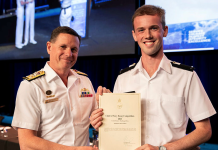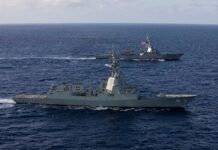
By Albert Caton
I’D ALWAYS remembered him as rather quiet. He would sit for ages in his smoker’s bow-armchair at the kitchen table with tobacco and papers making roll-your-own cigarettes. Finishing each one using an oversized match to tamp in the tobacco protruding at the ends, he would carefully place it under an elastic strip in his cigarette case. Curiously, I don’t recall him smoking; but perhaps that wasn’t permitted around the house.
He was my grandfather: Alfred William (‘Bert’) Reed. He was meant to be an ‘Albert’ like me, but his mother was deaf and thought that the registrar had said ‘Albert’ rather than ‘Alfred’. So, Alfred he was registered, but Bert he became.
He was in the Navy. The manifestation of that for me were fascinating ephemera – like medals; a hammock; parallel rules for map-plotting; little brass tokens to place on maps to represent ships; brass coupling-clips (‘Inglefield clips’) to simplify ‘bending’ strings of signal flags together; and he had a ship in a bottle on the kitchen mantlepiece. He was Chief Yeoman of Signals, working at Navy Office (which was in the big, old, ivy-covered, bluestone building on St Kilda Road) in Melbourne.
But he died in 1955, aged 60, from a massive heart attack at the tram stop on the way to work, bringing a forty-year navy career to an end.

That was about the limit of my understanding of Bert Reed. Only when I had the almost-infinite task of sorting through my mum’s family photographs and memorabilia did more background began to emerge. It led me eventually to his service-record card at the National Australian Archives and, subsequently, to searches on the National Library’s ‘Trove’ database of digitised newspapers – and, as the saying goes, ‘that’s where the story really starts’.
Bert was born in Geelong in 1894 and, when perhaps about 13 or 14, moved with his parents to his uncle’s property at Drouin (in Gippsland in Victoria). In 1912, aged not quite eighteen, he joined the Navy and was posted to the shore station HMAS Cerberus (located at Williamstown). In 1913 he was posted aboard HMAS Melbourne as a Signaller, and on New Year’s Day in 1914 he joined the Navy Flagship – the new battlecruiser, the first HMAS Australia.

What happened? The card provides no explanation; but for me it is straightforward. His only child, a daughter, my mother, was born on 26 April 1914, to my grandmother Vera Kerr who at the time was unmarried. Bert obviously deserted to be with his inamorata for the birth and then, a dad, returned to his ship. Aboard HMAS Australia at the declaration of the Great War, he served in it for the duration.
Later, back in Australia, he married Vera, re-enlisted, and continued his Navy career in signals until his death.
End of story? Actually, no. When attempting to find sources to fill in family-tree details — the normal fall-back having failed to talk about such things with him, my grandmother and other relevant relatives while they were still alive – I began some explorations on ‘Trove’ to see if there were any press references about the Reeds’ or Kerrs’ activities in Drouin. And there in front of me was the bombshell:
‘Weekly Times (Victoria.) Saturday 21 November 1914.
‘OFFICER AVENGED! GIPPSLAND YOUTH’S LETTER.
‘How one of his men avenged the death of Lieutenant-Commander Charles Bingham Elwell, who lost his life by a German bayonet when the Australians captured German New Guinea on September 12, is briefly told in a letter from Signaller Bert Reed, whose shot exacted retribution.
‘Signaller Reed is the son of Mr and Mrs W. Reed, of Drouin, and is on board H.M.A.S. Australia, from which vessel the party landed which captured the German possessions. In a letter written at sea, and just received by his parents, Signaller Reed says:
“You may have read in the papers that Lieutenant-Commander Elwell was run through with a bayonet. Well, I am very pleased to know that I shot the man who killed him. I was the signalman of No. 2 Company, and was with Lieutenant-Commander Elwell at the time. I used my rifle and pistol a lot, but how many others I killed or wounded I do not know.”
The article included a photograph of Bert. Several other press clippings provided similar accounts. Further searching about the campaign in New Britain quickly highlighted my total ignorance of Australia’s important activities in the first few weeks of the Great War. Yes, later, there was ANZAC cove; yes, there were horrors in the trenches on the Continent; but what was this campaign so soon after the declaration of war, so close to home, and the cause of Australia’s first casualties of that War?
In 1914, Germany held strategic territories in the equatorial and southern Pacific. At the outbreak of war the British Government, concerned about the significance of powerful wireless-transmission stations in those German territories, requested Australian support to neutralise them. After participating in joint British and French operations with New Zealand troops that put the stations at Samoa and Nauru out of action, the Australian ships involved sailed back to rendezvous with the remainder of the Australian fleet off New Britain.
Most of the fleet rendezvoused off Rabaul early on September 11. One party of 25 naval reservists, trained for shipboard service at sea rather than jungle fighting, was landed at Kabakaul to strike inland to the powerful station at Bita Paka. A second was landed at Herbertshohe (Kokopo) to head inland to the station believed to be under construction nearby at Toma.
The road from Kabakaul to Bita Paka was quite narrow with dense, occasionally impenetrable jungle flanking it. The naval party sought to proceed using the road verges for cover, so their progress was particularly slow. About one-and-a-half miles inland, two scouts forcing further into the undergrowth came across an armed ambush of three Germans and 20 native soldiers watching the advance of the main party. In the subsequent interchange of gunfire, Australia’s first actual fighting with the enemy in the Great War, a German was wounded and the two others were taken prisoner. Documents captured showed that the road ahead was trenched and defended in three places.
From that point onwards the party was subject to frequent gunfire from the cover of the dense forest and from native snipers hidden in trees, so that reinforcements were requested. Moving on slowly, the party was eventually joined first by further naval reservists, and subsequently an infantry machinegun section and an army medical detachment. However, in the interim the naval advance party and then the first reinforcements suffered casualties. A naval reservist (Able Seaman Williams) and then an army medico (Captain Pockley) were wounded and, later dying, became the Australian navy’s and infantry’s first casualties of the war.
The first of the defended trenches had checked further advance along the Bita Paka road. Lieutenant-Commander Elwell, who had come up with the final group of reinforcements, assumed control. About 80 metres from the trench he ordered the force to fix bayonets whereon, with sword in hand, he led a charge on the trench. He was killed almost immediately and so, sadly, was not to see that the show of strength was sufficient for the trench defenders to raise the white flag in surrender.
There were further confrontations at the subsequent two trenches, resulting in the deaths of Able Seamen Street and Walker and of Signalman Moffat; but by 7.00 pm the Bita Paka wireless station was in Australian hands.
The short duration of the move on Bita Paka and the handful of mortalities might tend to downplay the confrontation relative to the broad geographic scale of later campaigns such as ANZAC with its sheer numbers of servicemen killed and wounded. The New Britain front on which these sailors fought was not miles wide but just three or four metres. With virtually no cover, their war was no less threatening.
In the research reading room of the Australian War Memorial in Canberra one can look at a three-page, now-yellowing-and-foxed letter from Able Seaman ‘Gus’ Shea to his mum in Sydney. It gives a sobering personal account of the progress along the road. He says “I am still alive thank God and have been in one engagement and as long as I live I don’t want to see any more. It was fearful.” … “We struck the enemy and they fired on us pretty heavy. Bullets whistled all around us.” and later “It was terrible to hear the wounded scream; I don’t want to hear any more.”
Another sailor’s experience is reported in the 10 November 1914 edition of The New Zealand Herald. Timothy Sullivan, an Able Seaman from the South Australian Naval Brigade, received nine wounds from direct hits or from fragments of explosive bullets. His left hand was powder-scorched from a rifle shot received at close quarters, shattering several fingers to the point of probable amputation. Two bullets struck his left arm, but without serious injury; one found the point of his chin, leaving a nasty wound; a piece of lead from an explosive bullet was lodged under the left side of his jaw, awaiting removal; two of his teeth were knocked or blown out; his breast escaped with a charge of gun-shot, the pellets of which remained under the skin, while another bullet did no more harm than to rip away half of his belt and bandolier, harmlessly exploding half his ammunition.
From a hospital verandah ‘back home’, he was reported as saying: “I think I was hit over the eye at the onset, but I kept on, every now and again feeling something hitting me. We got almost to hand-to-hand fighting, and might have used our bayonets to better effect. I brought my rifle to the shoulder for a third shot, when my left hand was shattered at such close quarters that I felt the burn more than the pain of the wound. That finished me, and I was laid out and placed with two others.”
The Official History of Australia in the War of 1914–1918, the 12-volume series edited by the official historian Charles Bean and covering Australia’s involvement in World War I, includes a volume (Vol. X) on the capture and administration of the German possessions in the Southern Pacific. Chapter V in that volume describes (pp. 50-89) the seizure of New Britain. Grandfather Bert receives no mention, nor is he mentioned in Burnell’s 1915 book Australia versus Germany: the story of the taking of German New Guinea, nor in the late Kevin Mead’s 2005 book Heroes Before Gallipoli; Bita Paka and that One Day in September. This is fortuitous because, apart from the naval officers leading the various groups, those singled out by name were mainly those wounded or killed. That Bert participated is confirmed by a brief entry on his Certificate of Service record card under the section ‘any meritorious service’ which notes ‘Took part in the operations in German New Guinea Sept. 1914’.
So, what makes me write this? I am not suggesting that these New Britain deeds are little known or unrecognised among naval and historian circles. My education emphasised the significance of events such as ANZAC, and yet I was totally unaware of the New Guinea campaign even though my immediate relative participated. Hence, ‘Lest I forget’, I felt it necessary in his memory, and for the information of others who might have had my lack of awareness of such a significant anniversary, to draw attention to the Bita Paka engagement.
 *Unlike his father and grandfather, Albert Caton has had no naval service but managed 40 years association with the sea in his career as a fisheries biologist, specialising in international tuna fisheries.
*Unlike his father and grandfather, Albert Caton has had no naval service but managed 40 years association with the sea in his career as a fisheries biologist, specialising in international tuna fisheries.


